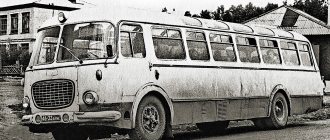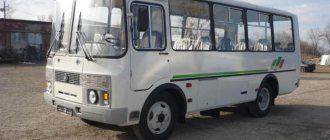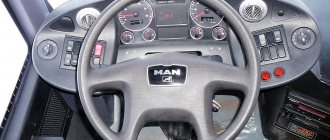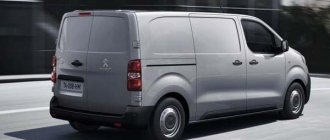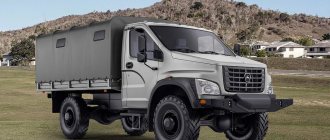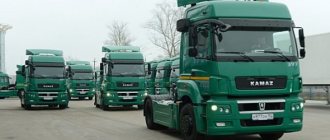Bus Ikarus 256. Photo Wikipedia
Ikarus 256 is a bus mass-produced by the Hungarian company Ikarus from 1977 to 2002. This model was almost completely unified with the Ikarus 250 model, but the body length was one meter shorter and amounted to 11 meters. Compared to the Ikarus 250, the 256th model became much more comfortable and had many new features and functions inherent in modern tourist buses. The bus can operate both as an intercity bus and as a tourist bus.
Description and device
The Ikarus 256 bus is exactly one meter smaller than the 250.59 model. The length of the bus is 11 meters, the height of the bus decreased by 10 centimeters to 3.10 meters, the width remained unchanged at 2.5 meters. The bus body is load-bearing, carriage-type, and looks completely square. The side skin of the bus consists of several welded steel sheets, is quite durable and easy to repair.
Universal bus Ikarus 256. Photo Wikipedia
The wheels of the bus, unlike the Ikarus 250 (most modifications) and Ikarus 255, are sometimes disc wheels ; they are identical to the wheels used on LAZ, LiAZ, MAZ and many other trucks and buses produced in 1970-1990. The wheel size is approximately 280R, the tires themselves are 11.00 R20 . The engine is located under the rear panel, it has become more powerful than that of the 250.59 and 255 buses, but the muffler is not good enough, which makes the engine loudly audible, especially on inclines and at low speeds. The volume of the luggage compartment has become larger.
Design. In the USSR, buses were mainly supplied with a white skirt, bright red sides and top paint scheme (since 1980, buses of the Ikarus 250.59 series began to be painted according to the same scheme). The design of the front of the bus is very similar to the design of the 250th model - the bumper is black, large, welded , the state number and fog lights (the lower part of the bumper) are placed on the bumper. The air intake is located above, it is not covered by anything, and the Ikarus emblem with the model number of the bus is placed on it. Headlights 4, two on each side , they are equipped with a lens coating and have very high power.
The windshield is panoramic, very large and divided in half. The windshield wipers are moved by traction arms and can operate in 3 modes. A tank with foam for glass washing can also be installed, although most buses do not have this function. The side windows are small in size, identical to other Ikarus buses, the side mirror on the right side is in the shape of “hare ears”. The rear part of the bus is the same as that of the 250 series buses: the casing is a single steel sheet, the lighting equipment has not changed. The rear bumper is welded steel.
Salon. Single-leaf doors. The front door drive is fully automatic (in 250 and 255 models both doors opened automatically). Both doors are glazed. The interior is modernized and more comfortable compared to similar models. The bus has 10 rows of seats with seats for passengers and, in addition, 5 seats in the back. All seats are installed on a platform ; they are much more comfortable than those installed on the Ikarus 255, soft type and twenty centimeters higher. The seats are covered with synthetic fabric.
Another design feature is the ability to move the seats on special rails a few centimeters apart from each other. The problem of cramping was partially solved by reducing the number of seats to 45. There is also an adjustable footrest (this was not possible in the 250 and 255 models).
The flooring of the cabin was made of linoleum , but it was not of sufficient quality, which is why it quickly became dirty and wet if people walked on it in shoes that were dirty and wet from precipitation. A big advantage was the large and light curtains , which protect from the sun much better than the standard red ones (the fact is that the Ikarus 200 series windows were not tinted).
Bus Ikarus 256. Photo Wikipedia
5 rear row seats create a kind of sleeping sofa, which is very comfortable, for example, for passengers with small children. The last row (seats No. 41-45) is located on two steps. There are additional windows on the sides of the last row.
This bus has much better ventilation than its predecessors: it has both forced air flow through the hatches and artificial air flow through sliding windows . Lamp-type lamps are installed in the cabin , although the lighting is much worse than that of modern tourist buses, which use several rows of lighting in the amount of 50-70 pieces.
Another innovation is the presence of a TV, which has become common on new buses. The disadvantage, compared to the Ikarus-250 bus, was the luggage racks. In Ikarus-250 they were solid with installed individual air conditioning and lighting systems. In the Ikarus-256 bus, they resembled those of the basic Ikarus-255 model, that is, they consisted of a metal frame covered with rubber with a stretched fabric mesh.
driver's cabin , instrument panels and steering wheel remain almost unchanged. Raba steering wheel with hydraulic booster, 7-speed gearbox (including “R”) ZF type gearbox, pedals have not changed - the accelerator pedal is small and similar to the pedal in a passenger car, the brake pedal is large rectangular.
The instrument panel remains unchanged: the tachometer is located on the left, auxiliary instruments on the right, and the classic “Ikarus” speedometer, marked up to 120 km/h, is located on the right. The right side of the auxiliary panel contains most of the keys and radio. There is no separate door from the driver's cabin, so some instruments are located on the left panel.
Dynamics. In terms of speed, the bus is almost as good as the airliners of that time; outside the city it travels at an average speed of 70-80 km/h and can reach speeds of over 100 km/h. Therefore, the Ikarus 256 is a universal bus that can operate as an intercity bus, a tourist bus, an excursion bus, and occasionally even a city bus.
Modifications
During the production of Ikarus 256, the following modifications were produced:
- Ikarus 256.21Н (From 2000 to 2002);
- Ikarus 256.44;
- Ikarus 256.50;
- Ikarus 256.51;
- Ikarus 256.54;
- Ikarus 256.74;
- Ikarus 256.75.
Passenger reviews
Bumper of the Ikarus 256 bus. Photo Wikipedia
The cabin can freely accommodate up to 50 people (47 to be exact). The seating area is located in two continuous rows on slight elevations along the walls.
The chairs are very comfortable . If desired the main backrest reclines if the passenger decides to go to bed on the road or take a short rest. But some rear passengers reported significant discomfort. In this form, the back of the front seat puts pressure on the legs. This applies to people with a height index higher than average.
A special shelf was placed on top , where a built-in ventilation mechanism was introduced. Individual lamps are also installed so that the passenger can read a book while traveling. But the solid side, large windows are not complemented by vents. During the summer season, air circulation in the bus could only be achieved thanks to the top hatch.
While driving, the Ikarus 256 moves smoothly , producing a set noise level. The smell of exhaust gases was often noticeable inside. In a frosty winter, it could be equally warm or cool inside. But this factor depended on the driver. The desire to save on fuel had a negative impact on passengers' opinions about the bus.
Driver reviews
Among everything else, the well-coordinated work of the steering system . The brake system works quite autonomously, but requires proper adjustment.
The clutch pedal is activated very easily, it is complemented by a pneumatic hydraulic booster. The area where the driver's cabin is located is quite high, in some ways it looks like a square. Thanks to this, management becomes easy . The hydraulic booster operates smoothly, with established stability.
Driving a bus is as easy as driving a car. The weight of a bus in those days exceeded 15 tons.
Among the disadvantages of the steering system, car owners note an extremely large turning radius . However, all the mirrors on the bus are convenient and informative.
Artifacts from the past
The chill-out of the soothing rumbling of a diesel engine to the accompaniment of the rear axle, occasionally interspersed with elements of dubstep when changing gears, is an excellent background for Stepan’s stories about the bus’s past.
– The mileage on the odometer is approaching five hundred thousand kilometers, but I think that we can safely add a million to them. Either the second lap, or the speedometer was changed. It is difficult to judge the originality of the mileage, but usually buses travel at least one hundred kilometers a day, usually even much more. This Ikarus drove the factory football team for some time, and there was even a stencil left of it. Interesting artifact.
At one time, optics for “Hungarians” were in short supply, so drivers scratched out the license plate on the “turn signals” so that they would not be transferred to another bus. Here you can see “37-00” on them.
The interior is completely original, nothing has been done to it. The covers that are put on the seats protected the “original” upholstery from wear. Apparently, the bus had very good drivers who loved it. And Ikarus simply forces himself to be loved.
Here is another example of the drivers’ love for the bus - a rug in a niche on the panel. Or squares on the steering wheel and handrails. I am not removing this tuning, because this is the history of the bus. I can’t imagine how much work it took to glue it all, and even make it out of such material that it could easily survive until 2022.
Along with the bus, we received many original interior elements in good condition; even an original first aid kit with Hungarian medicines was found on the shelf.
After the purchase, I really regretted that the original sign with the inscription Ikarus on a blue background was not preserved on the sides, and six months later I found it between the shelves in the bar in perfect condition. For now it’s just sitting there because I’m afraid it might get stolen.
Basic information, characteristics
- Manufacturer/manufacturer where the equipment is produced/manufactured. Ikarus (Ikarus) is a Hungarian bus manufacturing company specializing in the production of city, intercity and special buses. Founded in 1895 as a blacksmith and carriage workshop in Budapest. In the 1980s, it reached an annual production volume of up to 12 thousand cars per year, which placed Ikarus among the largest bus manufacturers in Europe. Currently a small private company.
- Purpose. Intercity, tourist, excursion, can be used on city routes.
- Class. Big.
- Body type. Carrier, carriage layout.
Exterior
As standard, the bus was painted red with a white stripe along the sides.
Almost all modifications are very similar and are equipped with the same body parts. These are voluminous metal bumpers with built-in fog lights, a narrow radiator grille with four round headlights. The Ikarus 256 is equipped with a viewing windshield with a central dividing partition. The bus has two doors located in the front and rear parts of the body. The rear one opens manually, and the front one is equipped with a pneumatic drive.
Engine/powertrain characteristics
- Model. RABA D10 UTSLL-155,P6 TD.
- Type. Diesel.
- Number and arrangement of cylinders. 6, in-line.
- Working volume, l. 10,35.
- Engine power, kW (hp)/min. 154 (210).
- Maximum torque, Nm/min. 883.
- Engine location. Rear.
- Checkpoint. CSA S6 90U six-speed manual.
- Front-rear axle suspension. Dependent, on two air springs, two longitudinal reaction rods, two shock absorbers; Dependent, on four air springs, two longitudinal and two A-shaped reaction rods, four shock absorbers.
- Control fuel consumption at 60 km/h, l/100 km. Ideally, the model in question takes up to 30 liters per 100 km. But for many buses this number is within the limit of 30 liters/100 km. On uneven road surfaces and with significant overload, the consumption component can increase by another 15 liters over a distance of 100 km. The fuel capacity in the model is extremely spacious. When the tank is fully filled, the fuel is completely consumed over 1000 km.
- Maximum speed, km/h. 106 (120).
Driver area
The driver's seat is designed as an open cab. All equipment in the driver's seat remains virtually unchanged, with the exception of minor additions and materials used. All controls and information instruments are located quite conveniently. Everything is done to ensure that the driver feels no less comfortable than the people in the cabin, does not get overtired and can drive the vehicle for quite a long time. A separate door for the driver is not provided for by the body design, so some of the equipment is located on the left side of the driver.
What you need to know about driving habits
During a test drive of the car, it was shown that with proper preparation, driving is simple and easy. The driver always has a good sense of the size of the vehicle, since its body is similar in size to a square. Changing gears is also very easy, the handle and gearbox respond quickly to tasks, but sometimes it’s just very difficult to get used to.
It is worth noting that while the engine is stopped, you cannot continue to roll forward in the neutral position of the gearbox lever. Then the hydraulic booster will stop and fail. And this is an unpleasant pleasure. This situation is extremely dangerous, since it will be very difficult for the driver to make a turn.
You can turn off the engine while driving, and this can be done quickly. During a descent, it is forbidden to press the brake pedal for a long time, because the discs themselves are poorly cooled.
If overheating occurs, the braking system may fail. Therefore, it is important to activate the required speed and the “extinguisher” (floor button), which will reduce the supply of fuel to the engine. This will create stronger brakes. If you activate this button during a descent in neutral, the engine will stop and the steering system will simply stop turning.
About the nuances
Around town, a very automatic transmission is lacking here. I need to squeeze the clutch, change gear, monitor the speed so that it doesn’t jerk, but moves off smoothly. So that the butt of no one standing in front is crushed. And you don’t need any other electronics here—everything you need is there.
The play was still small. Now it’s more, about 150 - I haven’t done the steering even once in 32 years, it’s already worn out. At maintenance 2, the current mechanics are afraid to lift it. The body underneath has rotted in some places, and when the bus needs to be “hung up,” everyone looks to see if it will fall off. It's no joke, it will cover 11 tons. In winter, it’s difficult with it if it’s not in a warm box. It runs on water, and not on antifreeze, like many buses now. To avoid freezing, you need to start it every two or three hours and warm it up. Turn on the heating boiler, close the radiator on both sides. The belts were removed from the fan so that it would not work and only the water pump would pump. Then the engine does not cool down longer.
Electrical equipment of the Ikarus 256 bus
The technical characteristics of electrical equipment and equipment have the following indicators.
The operating voltage of the on-board network is twenty-four volts. The machine is equipped with 2 batteries with a capacity of 182 ampere-hours. The power is turned on by connecting the ground to the button near the front bumper. The engine is equipped with an AVF VG901 generator, which generates 75 amperes and 28 volts of voltage. The engine is started by the AVF IV522 starter. Its power is 5.4 kW. The fuse box is located in the driver's cab.
Summary of the review
In general, the bus of the Hungarian company has good characteristics and is highly reliable.
Despite the emergence of new developments in this class of buses, the old Ikarus remains on the competitive line and is still widely used. Here is another fact that speaks of the popularity of the Ikarus 256 model. “Omsi” is a simulation game in which anyone can try themselves as a driver of a tourist, excursion or regular bus. This project also uses an exact copy of the brainchild of the Hungarian manufacturers in question.
So, we found out what technical characteristics, interior and exterior the Ikarus 256 bus has.
Differences in the parameters of models for different purposes
| Options | Tourist | Intercity | Urban | Suburban |
| Purpose | To cover long distances while ensuring comfort for passengers | To cover medium and long distances while ensuring comfort for passengers | For driving within the city on roads with high-quality, smooth surfaces | For covering short and medium distances on roads with imperfect surfaces |
| Floor location | High-floor | High-floor | In most cases low-floor | High-floor |
| Interior layout | Luggage compartments. A large number of seats, and, accordingly, narrow passages. Comfortable seats. | Luggage compartments. A large number of seats, and, accordingly, narrow passages. Comfortable seats. | Significant capacity is facilitated by the relatively small number of passenger seats and large storage areas. Wide aisles. Large doors. Convenient handrails. | Plenty of seating. Ability to develop significant speed. |
| dimensions | Mostly big | Mostly big | Mostly large and extra large | Mostly big |
| Peculiarities | Interesting design, the use of new solutions for specific periods of time, comfort, an extensive list of modifications, the creation of machines adapted for certain operating conditions | Interesting design, the use of new solutions for specific periods of time, comfort, an extensive list of modifications, the creation of machines adapted for certain operating conditions | Significant capacity, application of the latest solutions and technologies | Development and implementation of new effective solutions, comfort for passengers and convenience for the driver |
Historical reference
Ikarus-256 has been produced since 1977. Until 1998 it was produced in Hungary. The model has now been discontinued. However, you can still see this bus quite often on domestic roads. In the USSR, the presented vehicle was delivered by order of the government. The total number of cars that were imported into our country is about 150 thousand units. Tourist Ikarus of the presented model were imported in the amount of 10 thousand units per year.
In the 90s, the production of this bus was established in Poland, the Czech Republic and Hungary and several other countries. At this time, Ikarus were a very popular type of tourist transport. Their demand was explained by stable government orders. It is worth considering that in the 90s, many more comfortable buses of other brands were already produced, which exceeded the Ikarus in technical and operational characteristics.
Until 2000, the 256th model was popular among drivers. Spare parts for buses of this brand could be found everywhere, including on the balconies of drivers of different fleets. However, during these years, the demand for Ikarus gradually began to decline, as these buses were discontinued. They were replaced by more modern models with air conditioning, coffee makers and toilets.
From the author
The new Ikarus 256 are tireless wanderers, and the old ones are wanderers.
There are more and more wanderers, and fewer and fewer conventionally new cars. The last time I rode in such a luxurious “carriage” was 4 years ago (the history of the plant in Pest, by the way, began with a carriage workshop). The bus was ancient, in an extremely unkempt condition: with rotten lining, broken windows, seats dented, smoked incredibly and shook me along my native interregional highways for the entire 14 hours of the journey. But I got it! And it’s not surprising - the engine life of these cars is about 1 million km before the first “capital”. But the “Hungarians” had better times. When they were new, they quickly rushed along the roads of the Soviet republics, and our mothers, fathers and grandparents gently traveled in comfortable seats with two (!) types of adjustment. I also experienced this period as a child. I always wondered: how can the rubber on the windows be so black and smooth, and not cracked? How can a door on powerful pipes move forward on its own? How can a bus be so beautiful? It turns out that it can!
Motor
The engine in the car stands out with its 6 cylinders. The engine used is from Slave-MAN and is of the naturally aspirated type. It is characterized by a block arrangement. The motor is located in the rear body of the vehicle.
The engine begins to emit clouds of smoke during prolonged operation. And when parked, you can see several puddles of oil on the floor. This was common for any transport in those days.
The engine power is extremely small to overcome mountain roads, but for urban conditions it is enough. Therefore, moving through this area will be painful not only for passengers, but also for drivers. In such conditions you need to drive at speeds of up to 33 km/h. In this case, the engine can smoke and overheat at any moment.
Spare parts
In order for the driver to have the opportunity to carry out vehicle repairs during the trip, he had to have basic components with him just in case.
Any parts of the chassis could become damaged or stop working properly. And this especially concerned parts of buses with high mileage. The drivers of the vehicle were aware that it was necessary to carry a full set of parts in the luggage compartment. If an emergency situation occurred, it was always possible to fix the problem yourself.
Advanced drivers knew that it was better to buy several sets of parts at once. We also purchased several liters of motor oil, as well as additional hoses and a couple of floor-level taps. Since the times of the Soviet Union, many drivers have taken a spare wheel, brakes, etc. with them on the road.
Repair of a bus of this series could arise in various situations. Please note that spare parts for buses have always been freely available. In addition to quality repairs, system adjustments may have been required. This is an extremely important point, because the indicator directly affected the performance of the car and the reduction in fuel consumption.
Onboard electrics
The network in the presented vehicles is designed for 24 V. The system has 2 fairly large batteries. They ensure that the engine starts, and in cold weather also the heater. The latter, in turn, is an autonomous oven. It was intended to heat antifreeze, which, in turn, warmed the engine before starting the engine.
If the antifreeze taps are adjusted incorrectly, and the automation is excluded from the system, the bus could simply catch fire.
The bus's electrical system is quite simple. However, some of its components fail over time. They cannot be restored. Such elements include glass washers, wiper control, some valves and sensors.
Having examined the features and characteristics of the Ikarus-256, one can form an impression of this legendary bus of its time. These cars can sometimes be found on domestic roads to this day.
As they say in Hungary: “tu bi continuo”
During the period 1953-2003. (50 years!) The Hungarians supplied 150 thousand buses to the Soviet Union, and then to the Russian Federation. After the collapse of the USSR, Ikarush (that’s what they call him in his homeland) had a hard time: the plant changed owners several times, was divided, and production volumes fell. In 2003, the main production in Székesfehérvár was closed. Small-scale assembly was carried out at various enterprises both in Hungary and in Russia until 2006. In 2007, other divisions of the former Ikarus stopped working.
But the enterprise itself did not cease to exist. In January 2010, the plant restored its activities, making a living by overhauling old machines and producing traditional products. Already in March 2013, the new Ikarus Tr187.2, created in cooperation with Skoda, was presented.
And at the end of last 2013, information flashed that a new model range was ready, which they intended to put on the assembly line in 2014. The presentation was scheduled for this spring in Budapest.
